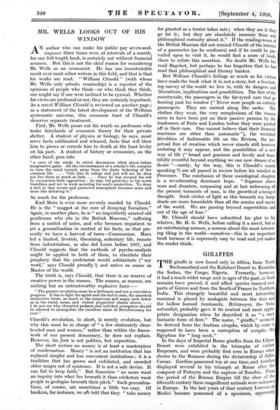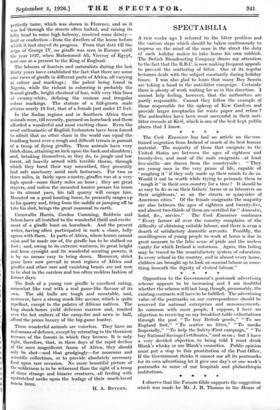GIRAFFES
THE giraffe is now found only in Africa, from North Bechuanaland and the Kalahari Desert to Kordofan the Sudan, the Congo, Nigeria. Formerly, however, it had a much wider range and in ages of the past, as fossil remains have proved, it and allied species roamed over parts of Greece and from the South of France to Northern India. This strangely beautiful and most interesting mammal is placed by zoologists between the deer and the hollow horned ruminants. Riitimever, the Swiss naturalist, probably gave it its neatest and most appro- priate *designation when he despribed it as a most fantastic form of deer." The name, "giraffe," seems to be derived from the Arabian zirapha, which by some s supposed to have been a corruption of zoraphe, the Egyptian for "long neck." In the days of Imperial Rome giraffes from the Libyan Desert were exhibited in the triumphs of various Emperors, and were probably first seen in Europe when shown to the Romans during the dictatorship of Julius Caesar. Gordian possessed ten at one time, and Aurelian displayed several in hiss triumph at Rome after the conquest of Pahnyra and the capture of Zenobia. From the period of the Roman Empire till the close of the fifteenth century these magnificent animals were unknown in Europe. In the last years of that centUry Lorenzo de Medici beaarne possessed of a specimen, apparently perfectly tame, which was shown in Florence, and as it was led through the streets often halted, and raising its lofty head to some high balcony, received some dainty— fruit or confection—from the dwellers of the house before which it had stayed its progress. From that date till the reign of George IV. no giraffe was seen in Europe until the year 1827, when Mahommed Ali, Viceroy of Egypt, sent one as a present to the King of England.
Thc labours of hunters and naturalists during the last thirty years have established the fact that there are some nine races of giraffe in different parts of Africa, all varying in colour and markings ; the palest being found in Nigeria, while the richest in colouring is probably the Somali giraffe, bright chestnut of hue, with very thin lines of creamy-white, defining the curious and irregular colour markings. The stature of a full-grown male attains nearly 19 fcet, that of a female just under 17 feet.
In the Sudan regions and in Southern Africa these animals were, till recently, pursued on horseback and there afforded a wonderful and most exciting chase. Even the most enthusiastic of English foxhunters have been forced to admit that no other chase in the world can equal the headlong burst over a rough and difficult terrain in pursuit of a troop of flying giraffes. These animals have very thick skins, attaining an inch upon the back and shoulders ; and, betaking themselves, as they do, to jungle and low forest, all heavily armed with terrible thorns, through which they burst their way unscathed, they presently find safe sanctuary amid such fastnesses. For two or three miles, in fairly open cauntiT, giraffes run at a very high speed—some thirty miles an hour ; they are great stayers, and unless the mounted hunter presses his horse to its utmost pace, his tall quarry will escape him. Mounted on a good hunting horse, he presently ranges up to his quarry and, firing from the saddle or jumping off to take his shot, brings the great mammal to earth.
Cornwallis Harris, Gordon Cumming, Baldwin and Mons have all testified to the wonderful thrill and excite rnent of a giraffe hunt on horseback. And the present writer, having often participated in such a chase, fully agrees with them. In parts of Africa, where horses cannot exist and be made use of, the giraffe has to be stalked on foot ; and, owing to its extreme wariness, its great height and keen eyesight and its wonderful scenting powers, it is by no means easy to bring down. Moreover, strict game laws now prevail in most regions of Africa and giraffes and other rare and vanishing beasts are not now to be shot in the careless and too often reckless fashion of former days.
The flesh of a young cow giraffe is excellent eating, somewhat like veal with a real game-like flavour of its own. The old bulls are tough and uneatable, and, moreover, have a strong musk-like savour, which- is quite repellent, except to the palates of African natives. The long shank-bones yield delicious marrow and, roasted over the hot embers of the camp-fire and sawn in half, afford the prime luxury of the big-game hunter.
These wonderful animals are voiceless. They have no real means of defence, except by retreating to the thorniest recesses of the forests in which they browse. It is only right, therefore, that, in these days of the rapid decline of the once magnificent fauna of Africa, they should only be shot—and that grudgingly—for museums and scientific collections, or to provide absolutely necessary food upon rare occasion. No more beautiful picture of the wilderness is to be witnessed than the sight of a troop of these strange and bizarre creatures, all feeding with upstretched necks upon the leafage of their much-loved acacia trees.
IL A. BRYDEN.



































 Previous page
Previous page